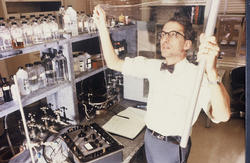Walther G.Grot
Walther G. Grot
Achtung Baustelle
CAUTION :
This site is under construction
This picture of me was taken about 35 years ago. The film I am holding up is made of NAFION*, which has become an important part of my life. This polymer is solid and inert like TEFLON*, but conducts electricity like the sulfuric acid electrolyte in your car battery.
* NAFION and TEFLON are DuPont trademarks
Sub-heading
More about me : I was born in Berlin in 1929. When the brand new Dreilindenschule (www.Dreilinden-Gymnasium.de) opened in 1939, I was one of the first students. In 1943, because of the increasing air raids, the schools in Berlin (children and teachers) were evacuated to Poland. My mother thought, going east was the wrong move in 1943, and found for me a place to live in the black forrest (good move). I have since tried to find out what happened to my class mates. Is one of them still alive ?
In Sept. 1945 my mother, sister Else and I moved to the Listerhof (www.Listerhof.de) an oasis of tranquility in a time of chaos. Later I studied chemistry in Goettingen and Marburg. I received my Ph.D in 1955 and in 1956 I took a job with DuPont. At DuPont I worked fo more than 38 years, mostly on the development of NAFION.
In 1978 I formed my own company (C.G.Processing, Inc.), working on custom fabrication and other aspects of NAFION that DuPont was not interested in.
More about my work : Go to : http://patft.uspto.gov/netacgi/nph-Parser?Sect1=PTO2&Sect2=HITOFF&p=1&u=%2Fnetahtml%2FPTO%2Fsearch-bool.html&r=0&f=S&l=50&TERM1=Grot+Walther&FIELD1=INNM&co1=AND&TERM2=&FIELD2=&d=PTXT
What are my children doing ? As parents, my wife and I always wonder what the children are up to. Find out at : http://appft1.uspto.gov/netacgi/nph-Parser?Sect1=PTO2&Sect2=HITOFF&p=1&u=%2Fnetahtml%2FPTO%2Fsearch-bool.html&r=0&f=S&l=50&TERM1=Grot+&FIELD1=IN&co1=AND&TERM2=&FIELD2=&d=PG01
More about NAFION* :
Introduction to NAFION *
Synthesis:
A meltfabricable precursor polymer is prepared by the copolymerization of TFE (C2F4, mw=100) and perfluoro 3,6-dioxa-4-methyl-7-octene sulfonyl fluoride (CF2=CFO-C3F6-O-C2F4-SO2F, mw446). Polymers of commercial interest have a typical mol ratio of about 6 TFE, resulting in an equivalent weight of 1046 (EW = 6x100 + 446 = 1046). (See photo) : The 2. and 3. reaction are catalyzed by fluoride ions (yellow). About 140 branches ending in the functional -SO2F group (red) are attached to the backbone (green) of a single molecule of precursor polymer, i.e. the mw of the polymer is about 150000.
After fabrication (extrusion, lamination) into the desired shape, the --SO2F groups are hydrolized by reaction with a hot solution of NaOH or KOH, and, optionally converted to the H+ form using HNO3.Unreinforced Films (NAFION 112, 1135, 115, 117 etc.):
The second digit indicates the EW (1 = 1100), the then following digit(s) the thickness in mils (except N 1135 = 3.5 mils). 1 mil = 0.0254 mm. N112 has now been replaced by solution cast N 212.These products are used in fuel cells (see photo), batteries, water electrolysis, ozone generation, gas separation/drying etc. They are sold in the H+ form; other ionic forms are available on request.
Reinforcements
All permanent reinforcements are made of TEFLON, woven either from a brown multifilament yarn or a white twisted ribbon. In general, a leno weave, in which the warp (=machine direction, MD) consists of a double yarn, twisted after each fill (=transverse, TD), is used (exception the now obsolete N 417 used a brown plain weave).
For maximum conductivity, white TEFLON reinforcement is used together with a sacificial fiber in a plain weave (typically 1 TEFLON alternating with 4 sacrificials). The sacrificial fibers are removed later, leaving open channels. Example: N 430 (K+ form).
Reinforced membranes are available in general purpose material (chromic acid regeneration, electrowinning, manufacture of KAu(CN)2 or K2SnO3 etc.) :N 424 (brown) and N 450 (white). High selectivity membranes have improved anion rejection (for instance for small scale NaCl electrolysis): N 324 (brown) and N 350 (white).
These reinforced membranes can be fabricated into tubes or bags.
For large scale NaCl electrolysis, membranes with carboxylic polymer on the cathode side of the membrane, are used (first digit 9).
More about NaCl Electrolysis :
Click on "My Photos" on top of this site, then go to : http://www.chlorine-eng.co.jp/eng/product/electro/electro2.html , click on "Figure 2" (above the red "feature 1" bar) of that site (neat diagram; point (don't click) mouse on the red dots); also click on "bipolar electrolyzers".
More about Fuel Cells :
Click on "My Photos" above, then go to : www.ion-power.com
Resin
NAFION NR 50 (extruded pellet, H+ form) is available for use as catalyst.
NAFION is stable against any aqueous and some nonaqueous (100% HNO3) agent at temperatures up to at least 1000 C. It may be attacked by elemental K, Na or F.All products mentioned above, including heat sealing service, are available from :
C.G. Processing, Inc., Box 133, Rockland, DE 19732
NAFION and TEFLON are DuPont’s registered trademarks.
Applications :
In almost all applications for films and membranes made of NAFION (Exception : Humidity exchange : http://www.permapure.com/TechNotes/Nafion%20physical%20&%20chemical.htm), the material is used as a separator in an electrochemical device to prevent mixing of the components of the anode and cathode compartments, while permitting the flow of current in the form of cations. Two examples are shown in the photos.
Other examples include the manufacture of plating chemicals (KAu(CN)2, K2SnO3, tin methane sulfonate etc.) by dissolving a metal anode in a suitable anolyte, the regeneration of spent chromic acid solutions and the manufacture of persulfates.
Some additional information can be found at www.wikipedia.com and
http://nafion.totallyexplained.com/
For the whole NAFION story, read my book "Fluorinated Ionomers" (William Andrew) http://www.williamandrew.com/titles/1541.htm
